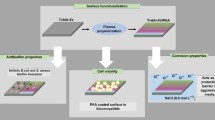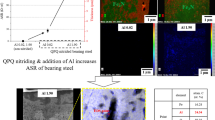Abstract
In this paper, the effect of toner particle addition on various features of aluminum oxide layers was studied. A new bath consisted of toner particles in the phosphoric acid solution was prepared to anodize of aluminum substrates. The toner particle content (3–10 g/L) acted as a variable parameter in the anodizing bath. Microstructural evaluations, the mechanical and electrochemical characteristics studies of produced layers were performed. Based on field-emission scanning electron microscopy (FE-SEM) images, it was observed that the mixing of toner particles into the anodizing bath affected the morphologies of oxide layers. The cell wall thickness of the oxide layers increased. When the toner particle content was 5 g/L in the anodizing bath, the wear rate and the coefficient of friction of the oxide layer showed the lowest values. Further, the indentation toughness value for the oxide layer raised to 3.98 MPa m0.5 when the toner particle content was 10 g/L. Due to the lower value of hardness, such behavior observed. The polarization test results illustrated that corrosion rates of produced layers decreased to 93.7% since the surface porosity percent and the mean pore diameter of produced layers decreased.











Similar content being viewed by others
REFERENCES
J. A. Wahab, D. M. Nazree, and A. H Iqwan, “Influence of anodizing voltage on formation of porous anodic aluminum oxide thin films in mixed solution of H3PO4 and CH3COOH, ” Adv. Environ. Biol. 7, 3708–3712 (2013).
T. Dimogerontakis and I. T. Kaplanoglou, “The influence of certain sulfonic triphenylmethane dyes, as additives, on anodizing of aluminum in phosphoric acid,” Thin Solid Films 385, 182–189 (2001).
T. Kikuchi, D. Nakajima, O. Nishinaga, S. Natsui, and R. O. Suzuki, “Porous aluminum oxide formed by anodizing in various electrolyte species,” Curr. Nanosci. 11, 560–571 (2015).
M. A. Korotin and E. Z. Kurmaev, “Electronic structure of aluminum oxide with oxygen vacancies,” Phys. Met. Metallogr. 119, 755–760 (2018).
L. Berndt, M. Kleemeier, K. Thiel, A. Hartwig, and M. Burchardt, “Anodization of aluminum in highly viscous phosphoric acid, Part 1: Investigation of anodic oxide layers by SEM and in-situ electrochemical impedance spectroscopy (in-situ EIS),” Int. J. Electrochem. Sci. 13, 8867–8888 (2018).
J. S. Zhang, X. H. Zhao, Y. Zuo, and J. P. Xiong, “The bonding strength and corrosion resistance of aluminum alloy by anodizing treatment in a phosphoric acid modified boric acid/sulfuric acid bath, ” Surf. Coat. Technol. 202, 3149–3156 (2008).
L. Zaraska, G. D. Sulka, and M. Jaskula, “The effect of n-alcohols on porous anodic alumina formed by self-organized two-step anodizing of aluminum in phosphoric acid,” Surf. Coat. Technol. 204, 1729–1737 (2010).
L. Zaraska, G. D. Sulka, and M. Jaskula, “Properties of nanostructures obtained by anodization of aluminum in phosphoric acid at moderate potentials,” J. Phys. 146, 1–10 (2009).
Y. F. Kuang, J. P. Liu, Z. H. Hou, and D. L. He, “Preparation and analysis of films on aluminium by high voltage anodization in phosphoric acid and sodium tungstate solution,” J. Appl. Electrochem. 32, 1267–1271 (2001).
I. Vrublevsky, V. Parkoun, J. Schreckenbach, and W. A. Goedel, “Dissolution behavior of the barrier layer of porous oxide films on aluminum formed in phosphoric acid studied by a re-anodizing technique,” Appl. Surf. Sci. 252, 5100–5108 (2006).
Y. Li, M. Zheng, L. Ma, and W. Shen, “Fabrication of highly ordered nanoporous alumina films by stable high-field anodization,” Nanotechnology 17, 5151–5161 (2006).
A. Hakimizad, K. Raeissi, and F. Ashrafizadeh, “Characterization of aluminum anodized layers modified in sulfuric and phosphoric acid baths and their effect on conventional electrolytic coloring,” Surf. Coat. Technol. 206, 2438–2445 (2012).
Y. Jia, H. Zhou, P. Luo. S. Luo, J. Chen, and Y. Kuang, “Preparation, and characteristics of well-aligned macroporous films on aluminum by high voltage anodization in mixed acid,” Surf. Coat. Technol. 201, 513–518 (2006).
Y. Mengshi, Z. Weikang, Z. Shaoyu, Z. Siwei, A. Fuping, and Z. Xufei, “Morphology evolution of porous anodic alumina in mixed H3PO4/NH4F electrolytes,” Surf. Coat. Technol. 334, 500–508 (2018).
P. Nezhadi, M. Azadi, and M. S. Bahaabad, “Effects of toner particles addition on fabrication and characterizations of aluminum oxide layers,” Surf. Interfaces 18, 100450 (2020).
M. Azadi, A. S. Rouhaghdam, and S. Ahangarani, “Mechanical behavior of TiN/TiC-n multilayer coatings and Ti(C,N) multicomponent coatings produced by PACVD, ” Strength Mater. 48, 279–289 (2016).
M. Peyqambarian, M. Azadi, and S. Ahangarani, “An evaluation of the effects of the N2/Ar gas flux ratio on various characteristics of TiC0.3N0.7 nano-structure coatings on the cold work tool steel by pulsed DC-PACVD,” Surf. Coat. Technol. 366, 366–374 (2019).
G. E. Thompson, R. C. Furneaux, J. S. Goode, and G. C. Wood, “Porous anodic film formation on aluminium substrates in phosphoric acid, ” Int. J. Surf. Eng. Coat. 56, 159–167 (1978).
H. Masuda, K. Yada, and A. Osaka, “Self-ordering of cell configuration of anodic porous alumina with large-size pores in phosphoric acid solution,” J. Appl. Phys. 37, 1340–1342, (1998).
W. Chen, J. S. Wu, and X. H. Xia, “Porous anodic alumina with continuously manipulated pore/cell Size,” Appl. Mater. Int. 2, 959–1302 (2008).
S. Lee, D. Kim, Y. Kim, U. Jung, and W. Chung, “Effect of aluminum anodizing in phosphoric acid electrolyte on adhesion strength and thermal performance,” Met. Mater. Int. 22, 20–25 (2016).
I. Vrublevsky, V. Parkoun, and J. Schreckenbach, “Analysis of porous oxide film growth on aluminum in phosphoric acid using re-anodizing technique, Appl. Surf. Sci. 242, 333–338 (2005).
M. Azadi, A. R. S. Rouhaghadam, and S. Ahangarani, “A review on titanium nitride and titanium carbide single and multilayer coatings deposited by plasma assisted chemical vapor deposition,” Int. J. Eng. 29, 677–687 (2016).
R. Canyook, P. Seubsom, J. S. Ngean, T. Trirujirapapong, and K. Taweesup, “Influences of sealing solutions on anodized layer properties of 7075 aluminum alloy,” Mater. Today: Proc. 5, 9483–9488 (2018).
L. Hemmouche, A. Meghalet, and A. Henni Chebra, “Influence of heat treatments on the fracture toughness of 2017A aluminum alloy,” Phys. Met. Metallogr. 119, 301–308 (2018).
Author information
Authors and Affiliations
Corresponding author
Rights and permissions
About this article
Cite this article
Nezhadi, P., Azadi, M. & Bahaabad, M.S. Investigation of Aluminum Oxide Layers Characteristics in Phosphoric Acid/Toner Particle Bath. Phys. Metals Metallogr. 122, 1367–1375 (2021). https://doi.org/10.1134/S0031918X21130147
Received:
Revised:
Accepted:
Published:
Issue Date:
DOI: https://doi.org/10.1134/S0031918X21130147




